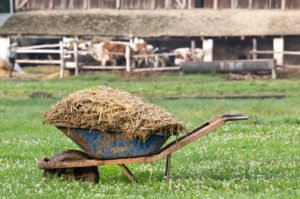
Let’s talk about sand — a simple and useful material in the country business. More precisely, the main aspects of its application. Sand is crushed and water-ground rock particles. With the right approach, this can significantly improve the physiological properties of the soil. How? I’ll tell you in detail.
The excellent property of sand to accumulate and retain heat is successfully used in the country economy, adding it to heavy soils, especially clay and loamy. Clay perfectly absorbs water, and when it dries, it shrinks, forming a heavy layer covered with cracks, which is very poorly tolerated by many plants. And sand successfully eliminates this problem, providing clay soil with good drainage.
The properties of sand
Sand varies by types: river, quarry, quartz and so on. I will not delve into the properties of each, since river sand is usually used for needs. In soils saturated with river sand, the roots of our green pets feel more than at ease, are densely branched and grow freely. Cuttings of plants take root well in sandstones, and when transplanting their tender roots are not damaged.

Sand helps to preserve moisture in the soil, is often used as a mulching material, strange as it sounds. And all because on hot summer days, even under a thin layer of sand, the soil remains moist, so there is no danger of drying out the roots on sandstones with irregular watering.
What grows well on sandy soils
On sandy and sandy loam soils, unpretentious plants take root well: centaur, irises, poppies and others. Representatives of the legume family also feel great on sandy soils, whose roots have their own bacterial environment that perceives sand quite friendly. Respect the sandy soil and many berry bushes: currant, honeysuckle, gooseberry, blackberry and others. These shrubs have a highly branched root system, which perfectly strengthens the porous sandy soil.

All kinds of coniferous trees and shrubs, many fruit and berry crops are perfectly adapted to sandy-clay soils. Also, alpine plants grow beautifully on soils with a high content of sand: bluebell, saxifrage, leontopodium and others, melons and grapes. Moreover, grapes growing on sandy and sandy loam soils practically do not suffer from phylloxera (a hard-to-remove aphid species).
Sand and fertilizers
Sandy soils are porous and saturated with oxygen, so the absorption of mineral and organic fertilizers by plants occurs very quickly and with maximum efficiency. Unfortunately, sand is not able to retain nutrients in the soil, because grains of sand cannot absorb nutrients, so clay is often added to sandy soils. If you are preparing a soil mixture for plants, the clay content should be at least 30%.
Mineral and organic fertilizers introduced into the sandy soil are enough to feed the plants only during the year. Fertilize should be done in early spring, and in autumn only manure and peat are applied. Fertilizers should be applied with great care: due to the porous structure of sandy soil, they immediately penetrate the root system and can “burn” the roots of plants. The best fertilizer that significantly improves the physiological properties of sandy soils is compost with the addition of peat, manure (2:1:1) and mineral fertilizers.
In addition, wood ash should be added annually to sandy soils: it slightly deoxidizes acidic soil and acts as a source of neutral potassium, phosphorus and other useful plant minerals. Ash is introduced into the soil in the ratio: 200 g (7 oz) per 1 sq.m of soil. Just do not make a rash with nitrogen fertilizer, otherwise it will lose its useful properties: the interval between the application of nitrogen-containing fertilizers and ash should be at least a month. Ash should not be buried in the ground, but simply sprinkled evenly under the plants: rain and melt water will deliver it to the desired depth.
Soil mixtures containing sand
Sand is used as a drainage material. It is useful to add it to almost every soil mixture. Let’s look at three main types of such mixtures:
- heavy consists of turf, humus and sand (3:1: 1);
- the average includes turf, humus and sand (2: 2: 1);
- light consists of earth, humus or turf and sand (1:3:1).
Young plants with weak root systems need light, well-drained sandy soils, and bulbous, powerful trees and shrubs need heavier soil.
Vulnerability of sandy soils
If you have sandy and sandy loam soils on your site, you should know that they are easily eroded, and the beds are deformed under the influence of natural factors. Therefore, place the beds across the slopes, fill up the ravines formed after heavy rains in time, leave some of the weeds in the aisles (which, of course, do not interfere with the growth of your green pets).

If possible, add clay and humus to sandy soils. Keep in mind that the soil saturated with sand is very sagging, so when planting seedlings, do not forget to tie them to pegs. Forming beds, dig up the earth to a depth of 0.4-0.5 m (1.3-1.6 ft), the bottom of the beds is tamped with clay for 10-15 cm (3.9-5.9 in) (you can lay old linoleum or put boards), and then fill the excavated earth back. This way you will avoid possible deformation of the beds.



